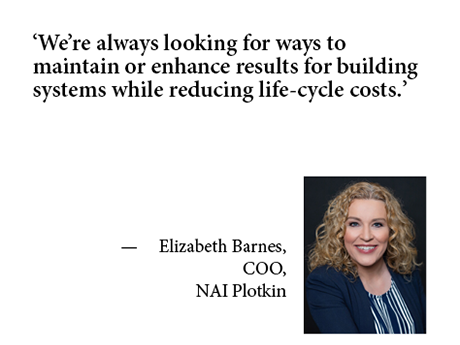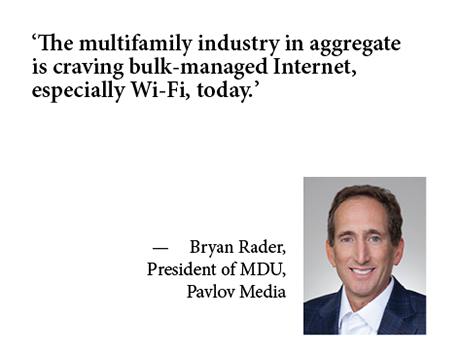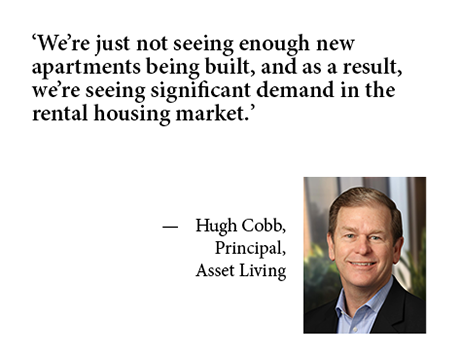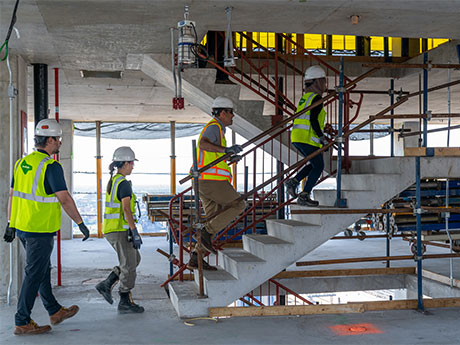By Stephanie Cramer, senior vice president of human resources, MGAC There is currently a demonstrable aging out of the construction workforce, and amid fierce competition for talent, the industry is facing headwinds of changing dynamics. Similarly, leaders are also recognizing that a younger and more diverse workforce is needed to stay relevant and to capably handle the challenges of tomorrow. As a result, construction recruiters are looking for ways to show students and young professionals that the architecture, engineering and construction (AEC) industries are truly becoming technology-driven fields in which they can feel supported and grow. As workforce strategy leaders at an international AEC-focused firm, we see every day what kinds of opportunities younger and more diverse professional populations are looking for — and what they’re not looking for. Meeting The Candidate One employable tactic is to reach new prospects at their level. In order to get in front of them, you must be able to reach them where they are, a process that typically means increasing social media engagement. By expanding their presences on a variety of channels — whether on LinkedIn, Twitter or Instagram — employers may be able to plant seeds that allow potential hires to feel …
Features
Elizabeth Barnes, COO of NAI Plotkin, knows property management is always a labor- and people-intensive profession, no matter the day or time of year. In that regard, the pandemic did not change the best practices for the Springfield, Mass.-based full-service brokerage and management company. “The number-one best practice has always been — and remains to this day — to manage the property as if you own it, with the awareness that you don’t,” Barnes says. Treat the Asset as Your Own For Barnes, this means focusing on the asset’s value at all times. “Common area maintenance (CAM) reconciliation, capital planning, value engineering options — they need to be front and center,” she continues. “It’s not just about cutting expenses. Look at how you can add value or reduce upfront costs.” All this should be done, she states, with the owner’s goals for the property in mind. Those goals may differ based on whether the owner is, for example, looking to divest the asset. Or if the tenant’s space has gone dark. Or if a pandemic is occurring. “There is a definite focus on health and safety now, regardless of the product type,” Barnes says. “Many owners wanted HVAC and air-handling …
SANTA BARBARA, CALIF. — After a long period of growth, U.S. multifamily asking rents seem to have finally hit a wall, according to Santa Barbara-based Yardi Matrix’s monthly National Multifamily Report. U.S. multifamily asking rents declined $1 to $1,718 in August — the first month-over-month period since June 2020 without significant growth. “The economy is starting to feel the effects of higher interest rates, while migration is slowing, and the increasing lack of affordability is affecting high-growth metros,” states the report. Asking rents increased in only 10 of Yardi Matrix’s top 30 markets in August, with Philadelphia, San Francisco and Nashville all showing a 0.5 percent growth rate. Metros with the largest decreases in asking rents included Raleigh (-1.3 percent), Seattle (-1.1 percent) and the Inland Empire and Las Vegas (both -0.8 percent). Yardi Matrix attributes this deceleration to multiple factors, including seasonality, cooling in markets that saw rents increase at extraordinarily high rates over the past two years and, most importantly, slowing migration and population figures. With a decreasing population growth rate and legal immigration dropping to its lowest level in decades, the report emphasizes that rent growth in the future is likely to be increasingly defined by migration …
CALABASAS, CALIF. — While the widespread adoption of the hybrid work-from-home model resulting from the COVID-19 pandemic is having a dampening effect on demand for office space, it also is proving to have a positive impact on certain segments of retail. Those were some of the key takeaways from a webcast hosted by Marcus & Millichap that featured Dr. Lawrence Summers, former secretary of the U.S. Department of the Treasury, who offered his insights on timely commercial real estate issues and the near-term outlook for the U.S. economy. Moderated by Marcus & Millichap CEO Hessam Nadji on Tuesday, Sept. 13, other featured speakers during the hour-long webcast included Conor Flynn, CEO of Kimco Realty Corp. (NYSE: KIM), and Swarup Katuri, managing partner at Brookfield Asset Management. The webinar, which was geared toward current and prospective investors in commercial real estate, attracted several thousand viewers, according to Marcus & Millichap, which is headquartered in Calabasas. “I think the sign is clear: Nobody is going to be going into the office more than they were before [the pandemic], and a lot of people are going to be going in less. Less because there’s going to be more flexibility, less because there’s some …
The landscape of multifamily Internet access is changing rapidly, driven by evolving resident expectations. No longer merely a utility, reliable Wi-Fi and Ethernet connections are essential for attracting and retaining residents, along with cutting operation costs. Expanding connectivity needs, work-from-home (WFH) culture and growing interest in smart-home applications are all driving residents’ Internet requirements. The centrality of Internet access for multifamily residents was inevitable in the long run, according to Bryan Rader, president of Multi-Dwelling Units (MDU) at Pavlov Media. COVID lockdowns accelerated an already burgeoning trend: bulk-managed Internet designed to improve connections and simplify growing demand. Bulk-managed connectivity offers a variety of solutions for on-site managers, residents and owners, as well as cost savings in unexpected areas. This approach provides building-wide Internet connections through a single provider, rather than asking residents to sign up individually with one of several Internet providers. The bulk Internet management company may also install and manage the building’s connection infrastructure. The simplicity of bulk-managed Internet (which started as bulk-managed Wi-Fi in student housing) is becoming increasingly practical for multifamily buildings. In the last four or five years, the traditional multifamily industry is starting to follow the same model that became standard in student housing …
WASHINGTON, D.C. — Greystar’s Jackie Rhone, a 35-year veteran of the multifamily industry, cut right to the chase when describing how the active adult niche differs from the traditional apartment sector in one big way for owners and operators. “This is the only time in my career that I’ve sold a lifestyle. I’m not selling four walls. They don’t care what your backsplash looks like. They want it to be nice, but that’s not what’s driving them,” said Rhone, referring to prospective residents of active adult communities. “What’s driving them is a lifestyle that you’re creating, and you can’t create that unless there are people living in your building that are showcasing that lifestyle.” Rhone, who earlier this month celebrated her 21st year with Greystar, serves as executive director of US Real Estate Services – Active Adult for the company. Under her watch, since mid-2019 Greystar’s active adult portfolio has grown from about 5,000 units and 27 properties to 17,000 units and 95 properties across 24 states. Her remarks came Wednesday during a panel discussion titled “Rational Exuberance: Investing in the Rapidly Growing Active Adult Segment” on the opening day of the 2022 NIC Fall Conference. Approximately 2,800 professionals descended …
As the commercial real estate market adjusts to how much of an effect higher interest rates will have on investment sales and property values, the rental housing sector continues to witness robust resident demand and rent growth as home ownership has become even more difficult for first-time buyers. According to a recent report by the National Multifamily Council (NMHC) and the National Apartment Association (NAA), by 2035 the U.S. needs to build 4.3 million new residential rentals to meet housing needs amid shifting demographics, the existing shortage and the loss of 4.7 million affordable units with monthly rental rates of $1,000 or less, the organizations report. “We’re just not seeing enough new apartments being built, and as a result, we’re seeing significant demand in the rental housing market,” says Hugh Cobb, a principal of Asset Living, one of the nation’s largest property managers of multifamily, affordable, student, active adult, single-family rentals and build-to-rent housing. “Because we’re seeing a decrease in demand in the single-family sales market due to higher mortgage rates, people are staying in apartments longer. And as their families grow, they’re looking for alternative rental housing, such as the build-to-rent space,” says Hugh Cobb. “Through our proprietary data …
ATLANTA — After a quarter characterized by rising costs of living and mounting inflation, “recession” is the word on everybody’s lips. But Roger Tutterow, professor of economics at Kennesaw State University in Georgia, states that “it is not a foregone conclusion that we’re in a recession today or that we’ll get there in the next several months.” The official definition of a recession is not two consecutive quarters of negative growth in gross domestic product (GDP). “Most of the time it works out that way,” Tutterow said, “but the technical definition of a recession is a period of diminishing activity in production, trade, employment and income.” Tutterow noted that looking at these four components of economic activity and comparing them to today indicates a softening economy and an elevated risk of recession, but he does not believe that the economy is necessarily contracting. He puts the risk of a recession in the next 12 months as roughly one chance in three. Tutterow’s assessment of the current state of the economy and his near-term outlook came during a keynote address Tutterow delivered at the ninth annual InterFace Seniors Housing Southeast, a networking and information conference hosted by France Media’s InterFace Conference …
Construction firms are eager to hire more employees, but a dearth of qualified workers has stymied their efforts, according to an annual workforce survey conducted by the Associated General Contractors of America (AGC) in conjunction with Autodesk. Among firms with job openings, 91 percent report they are having a hard time filling some or all positions. A total of 1,266 individuals from a broad range of construction firm types and sizes participated in the workforce survey conducted in July and August. Some 77 percent of contractors report there are few workers available who meet the minimum qualification standards, including being able to pass a drug test, which is something insurance companies require for all workers in the industry. With the unemployment rate in the construction industry hovering around 4 percent, finding qualified applicants is sure to remain a challenge in the near term, says Ken Simonson, AGC’s chief economist. “Construction workforce shortages are severe and having a significant impact on construction firms of all types, all sizes and all labor arrangements. These workforce shortages are compounding the challenges firms are having with supply chain disruptions that are inflating the cost of construction materials and making delivery schedules and product availability …
AcquisitionsCaliforniaContent PartnerDevelopmentFeaturesLeasing ActivityMultifamilyWalker & DunlopWestern
LA Multifamily Investment Deals See Volume Normalization, Pricing Resets for Select Assets
Multifamily investment transaction volume had an unprecedented year in 2021, and the first six months of 2022 were quite robust. Now, economic uncertainty in the form of rising interest rates and a cooling economy has created some hesitancy on the part of investors. “Some normalization is occurring in the market now, in addition to a pullback because of what is going on in the capital markets and economy,” says Paul Darrow, a managing director of Walker & Dunlop’s investment sales team based out of Los Angeles. Walker & Dunlop is one of the largest providers of capital to commercial real estate industry in the United States. Darrow sat down with REBusinessOnline to talk about multifamily investment sales trends in the Los Angeles area and the opportunities he sees for investors down the road. REBusiness: Investor interests have shifted in the past few months. What kinds of properties are investors most interested in now? Darrow: It’s a mixed bag when it comes to investor appetite. Those who raised money to buy specific types of buildings are obviously guided by what they’ve promised their investors in the form of return profiles and risk. Core funds, for example, can’t just switch to value-add or …











